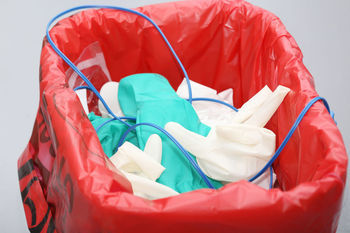Hospitals produce many different types of waste.
 Management writer Peter Drucker called the hospital the "most complex human organization ever devised."
Management writer Peter Drucker called the hospital the "most complex human organization ever devised."
Hospitals are bigger than most facilities that produce medical waste. And they produce different kinds of waste so they present a challenge to the professional medical waste manager.
Waste management at hospitals overlaps with safety and risk management. Your hospital has safety procedures in place and may have an infection control officer whose job it is to worry about the spread of disease. You also have facility management people who collect waste (as would happen in any building complex), and systems for fire control and suppression, personnel management in times of emergency, and evacuation and shut down criteria and procedures.
Waste aside, hospitals store and use materials that can hurt people. Flammable (and potentially explosive) gases and liquids, radiation sources, poisonous and cytotoxic medicines and cleaning chemicals, and physical objects that pose piercing threats (e.g. needles) and crushing threats (e.g. heavy items) are among the items hospital managers have to worry about.
This site is about waste and how to handle it, but hospital employees and administrators should remember that today’s raw materials are tomorrow’s waste. A lot of waste ends up hazardous because it was hazardous before it became waste, not because of hospital activities. That is a good reason to practice waste minimization techniques.
Most waste produced in hospitals is not specially regulated waste and does not differ substantially from waste produced at any other large facility where people work. This includes paper, packaging, food waste, etc.
We estimate 15 to 25 percent of hospital waste (by weight) is hazardous (or somehow regulated). That means most of it is not substantially different from the waste produced at an office building of comparable size and with a comparable population. This waste is classified as municipal solid waste (MSW) and can be put in the same landfill as waste from households and businesses outside the healthcare world. An estimated 10 percent (by weight) of hospital waste is infectious medical waste, and an estimated 3 percent is radioactive waste. About 2 percent is pathological waste. These are industry-wide averages so individual hospitals will have different percentages.
One study found that the operating room typically produces 20 to 30 percent of a hospital’s overall waste stream.
Hospitals produce sharps waste (e.g. needles, broken vials), clothing and protective gear that may be contaminated with bodily fluid (and hence infectious waste), blood-containing waste, and waste medicines.
The operating rooms further produce pathological waste and copious amounts of infectious waste as well as sharps not seen in the rest of the hospital (e.g. saws). It is also possible to get waste anesthetic gas and cleaning solutions that are particularly contaminated.
The Radiology section produces radioactive waste, and in the past made waste related to photography (e.g. silver, developing solutions, and acetic acid). If there is a Chemotherapy area, cytotoxic waste produced could include bulk chemotherapeutic agents; vials, gloves and safety material contaminated with cytotoxic agents; and contaminated excreta and urine. Many hospitals have nuclear medicine sections. While radiology is used to analyze the body, nuclear medicine encompasses methods to treat illness. The main radioisotopes used in hospitals are Technetium-99m (Tc-99m), Iodine-131(I-131), Iodine-125 (I-125), Iodine-123(I-123), Flourine-18(F-18), Tritium (H-3) and Carbon-14(C-14).
The engineering department probably produces what engineering departments at all big facilities produce: waste solvents, oils, lubricants, thinners, asbestos, and batteries.
You can employ whatever waste categories make sense for you, but because the regulatory system and waste management community have set designations, we recommend you at least start with these categories.
Waste that is radioactive must be stored in secure containers with the radiation symbol on it. Healthcare waste that is radioactive is classified as "low-level radioactive waste". It ultimately is sent to a landfill for disposal. There is often some sort of treatment before disposal to reduce the volume and make the waste more solid (to reduce likelihood of leaching of radioisotopes in a landfill), but this treatment usually does not happen at the hospital.
Infectious waste is anything that might cause disease in a human or animal who came in contact with it. Waste thought to have pathogens (bacteria, etc.) in enough quantity to infect a living host is considered biohazardous. In actual practice, materials with bodily fluids on them, even if there is no sign of disease in the person whose body they came from, are managed as infectious waste. This means blood, semen, amniotic fluid, cerebrospinal fluid, and fluid from the pericardial, pleural, and peritoneal cavities. Cultures and stocks from laboratory work are infectious waste. Used tubing, bandages, swabs and tissues are biohazardous waste.
 Actual solid (or semi-solid) body parts, including materials that have been removed by surgeons, are pathological waste, which may be thought of as a type of infectious waste, although it may be subject to different cultural and legal restrictions for treatment and disposal.
Actual solid (or semi-solid) body parts, including materials that have been removed by surgeons, are pathological waste, which may be thought of as a type of infectious waste, although it may be subject to different cultural and legal restrictions for treatment and disposal.
Note that waste from isolation wards is not necessarily infectious waste. Isolation ward and intensive care unit waste must be identified and categorized the same as any other waste at the facility.
Infectious waste must be disinfected or deactivated to some level so it does not present a hazard to employees and members of the public. Administrators and infection control officers worry about preventing HCAIs (healthcare associated infections.) The waste does not have to be sterilized before disposal -- that would be overkill because landfills are not sterile. However, any waste that is known to contain particularly virulent pathogens must be handled appropriately. At one time, hospitals incinerated biohazardous waste. Now it is more common for the waste to go to another facility for treatment and packaging before it goes to the landfill, but deactivation of virulent infectiousness should still happen at the hospital.
Waste that is classified as hazardous under the Resource Conservation and Recovery Act (RCRA) - usually because it has corrosive, flammable, or toxic chemicals in it - makes up 2 percent to 8 percent of total waste. In the US, this form of hazardous waste is subject to federal regulations by the EPA, while infectious waste - while it may be dangerous - is not covered by federal laws. Most US states and some local governments have regulations regarding storage and disposal of infectious waste. OSHA, a federal agency, also has regulations regarding exposure of employees to hazardous wastes.
The pathology and histology departments may produce waste containing solvents, which could possibly push the waste into RCRA hazardous waste. The pathology, dialysis, and nursing departments use formaldehyde which is classified by the government as a carcinogen. Formaldehyde is used to disinfect equipment and to preserve biological tissue. If your facility has an autopsy unit or prepares bodies for burial, formaldehyde is used there, too. Your operating theater may employ glutaraldehyde to disinfect and sterilize surgical equipment.
In short, many hospital activities have the potential to produce hazardous waste. Do a periodic audit of your facility to make sure have identified all sources.
The hospital’s in-house pharmacy typically carries more individual medicines than a retail drug store does. Large hospitals may stock 3000 to 4000 unique medicines. The management burden of having this many drugs on site is substantial. A well-functioning inventory record system assists the hospital management in understanding what is coming in, going out, and on the shelves at any time. This has value in itself - in operations management - plus it aids waste management systems which benefit from accurate materials information. In hospitals, waste epinephrine is the most common hazardous drug waste generated. It comes out of is used most often in cardiac care units and during orthopedic and ophthalmic surgical procedures but may be generated anywhere in the facility to treat cardiac arrest and allergic reactions.
Pharmaceutical waste is a challenge in itself. You probably want to keep in a separate collection stream. It can meet the standards for RCRA hazardous waste. Some drugs are poisonous and carcinogenic. Chemotherapy agents often make dangerous waste. Hospitals should maintain a special list of cytotoxic drugs on site for safety purposes and this list will inform waste management practices.
Pharmaceutical wastes can be hazardous or non-hazardous, and liquid or solid in nature. Some are genotoxic. Sort pharm waste into substreams.
Non-hazardous (keep in an area for non-hazardous pharm waste)
Hazardous waste that should be stored in accordance with their chemical characteristics (e.g. genotoxic drugs) or specific requirements for disposal (e.g. controlled drugs or antibiotics)
Due to its toxicity genotoxic waste should be stored away from other waste in a secure location. Use PPE when handling it. Few hospitals attempt to treat this waste on site. Make sure your waste disposal contractor knows what is genotoxic and carcinogenic pharmaceutical and knows how to handle it.
If you have a waste management plan in place and practice good segregation, most of your waste should be MSW. Avoid contaminating regular office waste with biological, hazardous, or radioactive material and you will have a lot less to worry about.
MSW can be collected on a less regular schedule than regulated waste. Your custodial staff may have a pattern for emptying trash cans, etc.
You will have to set up collection of MSW with a local garbage hauler. (They call themselves “waste management companies”.) They send trucks to unload your facility’s dumpsters. You will get charged by the dumpster load or truck load, i.e. by volume. You will probably find it useful to have a compactor on site to crush your MSW and cut its volume.
Ambitious hospital waste managers may want to try a composting system. As with recycling this will cut your quantity of MSW and may get you brownie points for community service. You won’t get any money for the compost material and you may have to pay to have it hauled to a compost facility. Check whether there are compost facilities in your area and whether there are incentives from local authorities. You can also ask operators of compost facilities for recommendations on waste haulers, and sometimes these operators have their own trucks for that purpose.
Food waste will make up most of what you send to composting. If you have grass clippings from facility maintenance, that might qualify also. Hospitals often have a lot of flowers in the waste, so they can also qualify.
More on collection and storage of waste at hospitals.
